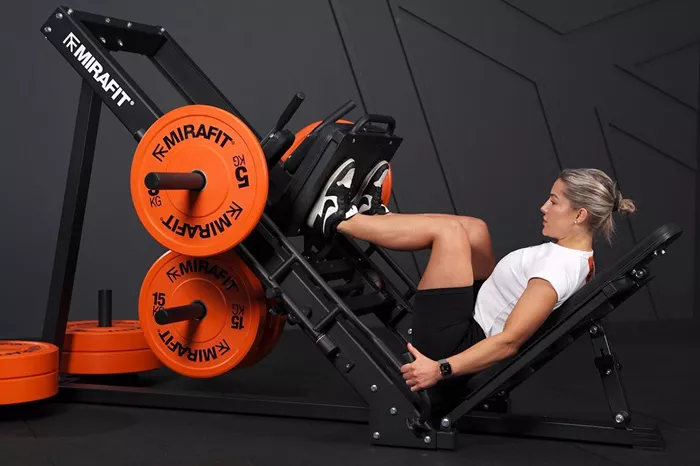The leg press is a popular strength training exercise designed to target the muscles of the lower body. It is widely used by fitness enthusiasts, athletes, and rehabilitation specialists to build muscle, increase strength, and improve endurance. This exercise involves pushing a weighted platform away from the body using the legs while seated or lying in a specific machine.
Understanding the Leg Press Machine
The leg press machine consists of a weighted platform attached to a sled, which moves along rails. The user places their feet on the platform and pushes it upward or away, depending on the machine design. The movement engages the quadriceps, hamstrings, glutes, and calves, making it an effective compound exercise for the lower body.
Types of Leg Press Machines
There are mainly three types of leg press machines:
- Horizontal leg press: The platform moves forward in a horizontal plane.
- 45-degree leg press: The platform moves diagonally at a 45-degree angle.
- Vertical leg press: The platform moves straight up and down.
Each type has slight variations in muscle activation and range of motion, but all effectively target the lower body muscles.
Muscles Worked by the Leg Press
The leg press primarily targets these muscle groups:
- Quadriceps: Located on the front of the thigh, these muscles extend the knee.
- Hamstrings: Located at the back of the thigh, responsible for knee flexion and hip extension.
- Gluteus Maximus: The main buttock muscle, important for hip extension.
- Calves: Specifically the gastrocnemius and soleus muscles, supporting ankle movement.
This combination makes the leg press a comprehensive lower body workout that improves strength and muscle tone.
How to Perform the Leg Press Correctly
Proper form is essential to maximize benefits and minimize injury risk when doing the leg press. Follow these steps:
- Set up the machine: Adjust the seat and platform position so your knees bend roughly 90 degrees when feet are on the platform.
- Foot placement: Place your feet shoulder-width apart in the middle of the platform. Avoid placing feet too high or too low.
- Position your body: Sit back against the seat with your back and head supported.
- Execute the movement: Press the platform away by extending your legs, keeping your feet flat and knees aligned with your toes.
- Return slowly: Lower the platform back to the start position with control, stopping before your knees lock.
- Breathing: Exhale as you press and inhale as you return.
Common Mistakes to Avoid
- Allowing knees to cave inward or bow outward.
- Locking the knees at full extension.
- Lifting the lower back off the seat.
- Using too much weight leading to poor form.
Benefits of the Leg Press Exercise
The leg press offers many advantages, making it a staple in many training routines:
- Muscle Building: It helps build strong, defined leg muscles efficiently.
- Joint Support: Strengthens muscles that support the knee and hip joints.
- Controlled Movement: The machine guides the movement, reducing injury risk.
- Improved Athletic Performance: Enhances power and explosiveness in running and jumping.
- Rehabilitation: Often used in rehab programs to regain leg strength safely.
Leg Press vs. Squats: Which One is Better?
Both exercises are excellent for the lower body but have differences:
- Squats: Engage more core and stabilizer muscles. They require balance and coordination.
- Leg Press: Focus more isolated effort on leg muscles. The machine supports your back and limits movement range.
The choice depends on your goals, fitness level, and injury status. Many fitness experts recommend including both for a balanced routine.
Integrating Leg Press into Your Workout Plan
When incorporating leg press into your workout, consider these tips:
- Use it as a primary leg workout or as a complement to squats and lunges.
- Adjust sets, reps, and weight based on your fitness goal:
- For strength: 3-5 sets of 4-8 reps with heavier weights.
- For muscle endurance: 3-4 sets of 12-15 reps with moderate weights.
- Rest between sets for 60-90 seconds.
Sample Leg Press Workout
Warm-up: 5-10 minutes of light cardio exercise or dynamic stretching.
Leg Press: 4 sets of 10 reps with moderate weight.
Walking lunges: 3 sets of 12 steps per leg.
Calf raises: 3 sets of 15 reps.
Cool down: Stretching leg muscles.
Safety Tips and Precautions
To prevent injuries, follow these safety tips when doing leg presses:
- Start with lighter weights to learn correct form.
- Do not lock your knees at full extension.
- Keep your back flat against the seat to avoid strain.
- Stop immediately if you feel sharp pain.
- Consult a fitness professional if unsure about technique.
Leg Press and Anaerobic Training
The leg press is a key exercise in anaerobic training. Anaerobic exercises involve short bursts of high-intensity effort without relying on oxygen as the primary energy source. Because leg press workouts typically use heavy weights and low repetitions, they fit well within anaerobic protocols that promote muscle strength and hypertrophy.
Leg Press for Anaerobic Training at Home
If you have access to a leg press machine at home or in a private gym, you can include it in your anaerobic exercise routine. Combine it with other anaerobic exercises such as sprints, jump squats, or resistance training to maximize muscle growth and power development. For more tips on anaerobic training at home, consult specialized guides and workout plans.
Conclusion
The leg press is a versatile and effective exercise for building lower body strength. It targets multiple muscle groups and supports safe, controlled movement. Whether you are an athlete, a fitness enthusiast, or recovering from injury, the leg press can be tailored to fit your goals. Incorporating it alongside other exercises and considering proper technique and safety ensures maximum benefit. For those interested in anaerobic training, the leg press is a valuable component of strength and power workouts.

